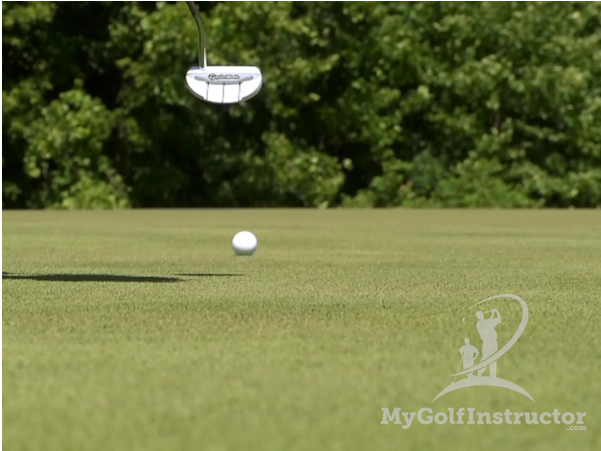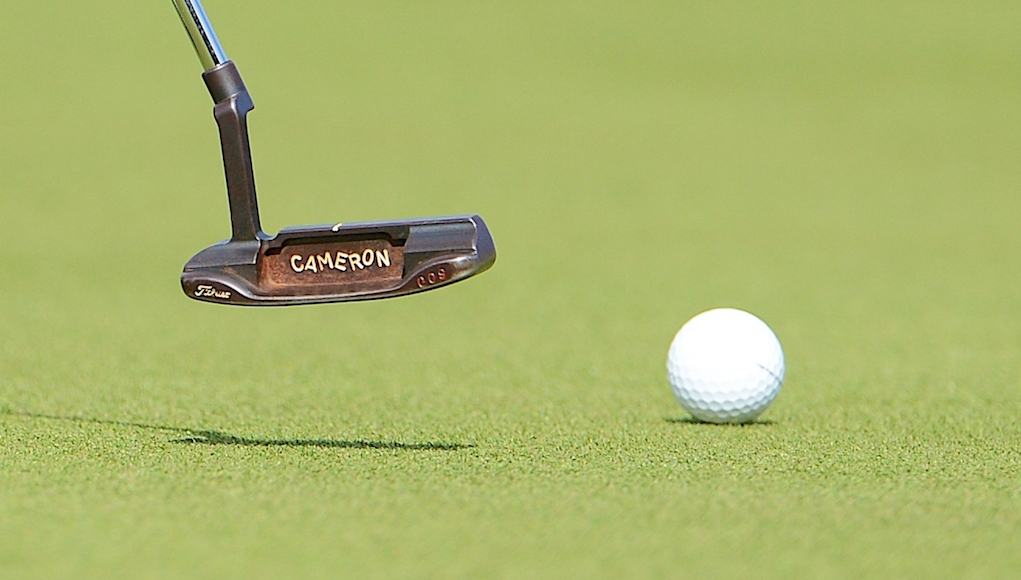Instruction
The King of All Golf Stats? First Putt Distance
If you were going to track one stat and one stat only on each round you played to help lower your scores, which stat would it be? GIR? Fairways Hit? Putts Per Round?
If you are a tour player, your answer might be that just one stat would not cut it. At the highest level of competition, golfers need to know where they stand on every single stat possible to analyze their entire game against their fellow competitors. For the average player, however, that’s a little complicated. It’s difficult and also time consuming to try to track every stat on every hole for every round you play. In addition, you might not need the most advanced statistical analysis to identify areas of your golf game that need the most attention.
You didn’t have to ace statistics to track golf stats
I don’t consider myself to be the smartest person in the room, but I have always been a hard worker. In college, I graduated in 4]four years playing competitive golf year round and managed a 3.5 GPA. However, one of the 2 “C”s I received in college was in — guess what — statistics!
I hated the class and simply just didn’t grasp it that well. I wasn’t much better with statistics on the golf course to be honest. I played collegiate golf in the early 90’s and while I’m sure some coaches were tracking detailed stats, ours was not. Of course, everyone was tracking scoring average, but they weren’t tracking all the individual stats that have now become common. When I turned professional I should have, would have, could have done a much better job of tracking my stats and analyzing my weak spots. If only I could turn back time.
In any case, golf statistics have evolved and exploded since then, and online stat trackers have popped up everywhere. Golfers and instructors are realizing the insights that any golfer can get from studying their stats from rounds of golf. I decided that instead of getting left behind, I better join the movement. So when my partners and I set out to create the MyGolfInstructor.com Game Tracker, we wanted to create a tool that anyone could use to easily track the stats they wanted, but more importantly, to give the golfer a detailed analysis of their game based on those stats. We wanted this not only to allow golfers to analyze their stats, but to have a tool whereby the instructor offers targeted analysis on those stats as well. In some cases, golfers see the stats they want to see, but an unbiased analysis of your golf stats can reveal even more opportunities for improvement. Use of the Game Tracker has helped me to improve my student’s games quicker and more efficiently than ever before. It’s not all about swing and mechanics anymore. It’s not all about mental game, physical fitness and equipment either. It’s about finding the really weak areas of the game first and attacking them from every angle. Numbers don’t lie.
When I started analyzing stats for the first time with rounds entered into our Game Tracker, I have to admit I was a bit overwhelmed. Where should I start with each student? What stat is the most important? Which part of the game should they try to improve first? It’s easy to get caught up in the usual stats: Putts, Fairways Hit and Greens in Regulation. After a couple of months though, I quickly became comfortable and efficient at being able to target the weak point on each card. I soon noticed an interesting trend.
The King of All Stats: First Putt Distance
My eyes would always jump to the putting stats first because it seems to be the easiest place for the average player to improve and is also the easiest place for the average player to waste a myriad of shots. Anyone who read my previous article The 5 Principles of Putting, knows that it is a part of the game I feel the average player can compete to the level of a tour pro. There was something beyond the total number of putts, however, that stood out on every card. I nicknamed it “The King of All Stats:” First Putt Distance.

Your first putt distance is a crucial stat.
First Putt Distance is the key to so much information about a player’s game and it syncs up well with four other common stats:
- Putts per round.
- Made putt distance.
- Chipping.
- Approach club.
Obviously, First Putt Distance tells us why a golfer’s putting average is high or low. If someone is always hitting their first putt from more than 20 feet, then I’m not surprised when they come in with putting rounds consistently averaging above 31 or 33 putts per round (the target I set for my students). If I know their first putt was from 30 feet and the putt they made was from 10, then I know their speed control stinks. You can see by the chart below pulled from our Game Tracker that the average first putt is a strong 15 feet.

While this is way better than I would have guessed for most players, it still makes it difficult to make one putts and our stats show that most golfers rarely make their first putt. We know from Dave Pelz’ research that tour players make only 50 percent of their putts from 6 feet, so we know for the average player to leave a putt outside of 6 feet makes the chances of sinking it miniscule. As far as Made Putt Distance goes, this graph clearly shows that 3 feet is the range where the average player can sink a putt.

According to Dave Pelz, tour players make 92 percent of putts from this distance, so it makes sense that it would be an easier range for the everyday golfer as well.
First Putt Distance also tells me a lot about a golfer’s chipping skills. If I can see that a player had to chip on seven holes and then I’m able to look and see that their first putts are always outside of 10 feet, then I know we have a problem in the short game. As you can see by the chart below, the average number of chips per round is 10! This one was much higher than I thought it would be, but again it emphasizes how important skilled chipping is to lowering that First Putt Distance stat.

The approach club used can signal weaknesses
The other key stat that gives us a lot of information is approach club. Again, if their First Putt Distance is always 20+ feet, then I know they aren’t hitting the ball tight to the pin. This prompts me to see what clubs they are hitting that are leaving them with such long first putts, and then we have clubs to target with improved ball striking. Our research shows that the difference between a “good” golfer and an “average/bad” golfer when it comes to these numbers is that a “good” golfer does a lot better on approaches. Maybe they aren’t consistent with having the first putt on the green being a makeable distance, but frequently getting a good approach gives them a better chance at a one putt and less of a chance of three putting.
It’s easy to see that every golfer should chart their First Putt Distance, as it gives them great insight into how well they are putting, chipping and approaching the green. Unfortunately only 15 percent of golfers on the Game Tracker track this vital stat. It’s as simple as taking the time to walk off the length of your first putt while you are going through your pre-shot routine and lining up your putt. If you aren’t already, start tracking your First Putt Distance this summer and I promise you that you will quickly gain insight into what part of your game is really adding the strokes. Here is a link to our Game Tracker to help get you started.
Instruction
The Wedge Guy: Beating the yips into submission

There may be no more painful affliction in golf than the “yips” – those uncontrollable and maddening little nervous twitches that prevent you from making a decent stroke on short putts. If you’ve never had them, consider yourself very fortunate (or possibly just very young). But I can assure you that when your most treacherous and feared golf shot is not the 195 yard approach over water with a quartering headwind…not the extra tight fairway with water left and sand right…not the soft bunker shot to a downhill pin with water on the other side…No, when your most feared shot is the remaining 2- 4-foot putt after hitting a great approach, recovery or lag putt, it makes the game almost painful.
And I’ve been fighting the yips (again) for a while now. It’s a recurring nightmare that has haunted me most of my adult life. I even had the yips when I was in my 20s, but I’ve beat them into submission off and on most of my adult life. But just recently, that nasty virus came to life once again. My lag putting has been very good, but when I get over one of those “you should make this” length putts, the entire nervous system seems to go haywire. I make great practice strokes, and then the most pitiful short-stroke or jab at the ball you can imagine. Sheesh.
But I’m a traditionalist, and do not look toward the long putter, belly putter, cross-hand, claw or other variation as the solution. My approach is to beat those damn yips into submission some other way. Here’s what I’m doing that is working pretty well, and I offer it to all of you who might have a similar affliction on the greens.
When you are over a short putt, forget the practice strokes…you want your natural eye-hand coordination to be unhindered by mechanics. Address your putt and take a good look at the hole, and back to the putter to ensure good alignment. Lighten your right hand grip on the putter and make sure that only the fingertips are in contact with the grip, to prevent you from getting to tight.
Then, take a long, long look at the hole to fill your entire mind and senses with the target. When you bring your head/eyes back to the ball, try to make a smooth, immediate move right into your backstroke — not even a second pause — and then let your hands and putter track right back together right back to where you were looking — the HOLE! Seeing the putter make contact with the ball, preferably even the forward edge of the ball – the side near the hole.
For me, this is working, but I am asking all of you to chime in with your own “home remedies” for the most aggravating and senseless of all golf maladies. It never hurts to have more to fall back on!
Instruction
Looking for a good golf instructor? Use this checklist

Over the last couple of decades, golf has become much more science-based. We measure swing speed, smash factor, angle of attack, strokes gained, and many other metrics that can really help golfers improve. But I often wonder if the advancement of golf’s “hard” sciences comes at the expense of the “soft” sciences.
Take, for example, golf instruction. Good golf instruction requires understanding swing mechanics and ball flight. But let’s take that as a given for PGA instructors. The other factors that make an instructor effective can be evaluated by social science, rather than launch monitors.
If you are a recreational golfer looking for a golf instructor, here are my top three points to consider.
1. Cultural mindset
What is “cultural mindset? To social scientists, it means whether a culture of genius or a culture of learning exists. In a golf instruction context, that may mean whether the teacher communicates a message that golf ability is something innate (you either have it or you don’t), or whether golf ability is something that can be learned. You want the latter!
It may sound obvious to suggest that you find a golf instructor who thinks you can improve, but my research suggests that it isn’t a given. In a large sample study of golf instructors, I found that when it came to recreational golfers, there was a wide range of belief systems. Some instructors strongly believed recreational golfers could improve through lessons. while others strongly believed they could not. And those beliefs manifested in the instructor’s feedback given to a student and the culture created for players.
2. Coping and self-modeling can beat role-modeling
Swing analysis technology is often preloaded with swings of PGA and LPGA Tour players. The swings of elite players are intended to be used for comparative purposes with golfers taking lessons. What social science tells us is that for novice and non-expert golfers, comparing swings to tour professionals can have the opposite effect of that intended. If you fit into the novice or non-expert category of golfer, you will learn more and be more motivated to change if you see yourself making a ‘better’ swing (self-modeling) or seeing your swing compared to a similar other (a coping model). Stay away from instructors who want to compare your swing with that of a tour player.
3. Learning theory basics
It is not a sexy selling point, but learning is a process, and that process is incremental – particularly for recreational adult players. Social science helps us understand this element of golf instruction. A good instructor will take learning slowly. He or she will give you just about enough information that challenges you, but is still manageable. The artful instructor will take time to decide what that one or two learning points are before jumping in to make full-scale swing changes. If the instructor moves too fast, you will probably leave the lesson with an arm’s length of swing thoughts and not really know which to focus on.
As an instructor, I develop a priority list of changes I want to make in a player’s technique. We then patiently and gradually work through that list. Beware of instructors who give you more than you can chew.
So if you are in the market for golf instruction, I encourage you to look beyond the X’s and O’s to find the right match!
Instruction
What Lottie Woad’s stunning debut win teaches every golfer

Most pros take months, even years, to win their first tournament. Lottie Woad needed exactly four days.
The 21-year-old from Surrey shot 21-under 267 at Dundonald Links to win the ISPS Handa Women’s Scottish Open by three shots — in her very first event as a professional. She’s only the third player in LPGA history to accomplish this feat, joining Rose Zhang (2023) and Beverly Hanson (1951).
But here’s what caught my attention as a coach: Woad didn’t win through miraculous putting or bombing 300-yard drives. She won through relentless precision and unshakeable composure. After watching her performance unfold, I’m convinced every golfer — from weekend warriors to scratch players — can steal pages from her playbook.
Precision Beats Power (And It’s Not Even Close)
Forget the driving contests. Woad proved that finding greens matters more than finding distance.
What Woad did:
• Hit it straight, hit it solid, give yourself chances
• Aimed for the fat parts of greens instead of chasing pins
• Let her putting do the talking after hitting safe targets
• As she said, “Everyone was chasing me today, and managed to maintain the lead and played really nicely down the stretch and hit a lot of good shots”
Why most golfers mess this up:
• They see a pin tucked behind a bunker and grab one more club to “go right at it”
• Distance becomes more important than accuracy
• They try to be heroic instead of smart
ACTION ITEM: For your next 10 rounds, aim for the center of every green regardless of pin position. Track your greens in regulation and watch your scores drop before your swing changes.
The Putter That Stayed Cool Under Fire
Woad started the final round two shots clear and immediately applied pressure with birdies at the 2nd and 3rd holes. When South Korea’s Hyo Joo Kim mounted a charge and reached 20-under with a birdie at the 14th, Woad didn’t panic.
How she responded to pressure:
• Fired back with consecutive birdies at the 13th and 14th
• Watched Kim stumble with back-to-back bogeys
• Capped it with her fifth birdie of the day at the par-5 18th
• Stayed patient when others pressed, pressed when others cracked
What amateurs do wrong:
• Get conservative when they should be aggressive
• Try to force magic when steady play would win
• Panic when someone else makes a move
ACTION ITEM: Practice your 3-6 foot putts for 15 minutes after every range session. Woad’s putting wasn’t spectacular—it was reliable. Make the putts you should make.
Course Management 101: Play Your Game, Not the Course’s Game
Woad admitted she couldn’t see many scoreboards during the final round, but it didn’t matter. She stuck to her game plan regardless of what others were doing.
Her mental approach:
• Focused on her process, not the competition
• Drew on past pressure situations (Augusta National Women’s Amateur win)
• As she said, “That was the biggest tournament I played in at the time and was kind of my big win. So definitely felt the pressure of it more there, and I felt like all those experiences helped me with this”
Her physical execution:
• 270-yard drives (nothing flashy)
• Methodical iron play
• Steady putting
• Everything effective, nothing spectacular
ACTION ITEM: Create a yardage book for your home course. Know your distances to every pin, every hazard, every landing area. Stick to your plan no matter what your playing partners are doing.
Mental Toughness Isn’t Born, It’s Built
The most impressive part of Woad’s win? She genuinely didn’t expect it: “I definitely wasn’t expecting to win my first event as a pro, but I knew I was playing well, and I was hoping to contend.”
Her winning mindset:
• Didn’t put winning pressure on herself
• Focused on playing well and contending
• Made winning a byproduct of a good process
• Built confidence through recent experiences:
- Won the Women’s Irish Open as an amateur
- Missed a playoff by one shot at the Evian Championship
- Each experience prepared her for the next
What this means for you:
• Stop trying to shoot career rounds every time you tee up
• Focus on executing your pre-shot routine
• Commit to every shot
• Stay present in the moment
ACTION ITEM: Before each round, set process goals instead of score goals. Example: “I will take three practice swings before every shot” or “I will pick a specific target for every shot.” Let your score be the result, not the focus.
The Real Lesson
Woad collected $300,000 for her first professional victory, but the real prize was proving that fundamentals still work at golf’s highest level. She didn’t reinvent the game — she simply executed the basics better than everyone else that week.
The fundamentals that won:
• Hit more fairways
• Find more greens
• Make the putts you should make
• Stay patient under pressure
That’s something every golfer can do, regardless of handicap. Lottie Woad just showed us it’s still the winning formula.
FINAL ACTION ITEM: Pick one of the four action items above and commit to it for the next month. Master one fundamental before moving to the next. That’s how champions are built.
PGA Professional Brendon Elliott is an award-winning coach and golf writer. You can check out his writing work and learn more about him by visiting BEAGOLFER.golf and OneMoreRollGolf.com. Also, check out “The Starter” on RG.org each Monday.
Editor’s note: Brendon shares his nearly 30 years of experience in the game with GolfWRX readers through his ongoing tip series. He looks forward to providing valuable insights and advice to help golfers improve their game. Stay tuned for more Tips!





















Pingback: How Can I Break 90 In Golf – The Annika Academy
Nagah
Apr 22, 2014 at 7:26 am
Thats why I practice only lagging 30/25/20 down to 12 feet. Statistically I have a small chance of holing a put from outside 12 feet as apposed to the opposite stat of 3 putting by being aggressive on my first putt being high.
I played in a comp today and stiffed about 3 approaches inside 10 feet and only converted one for birdie. Im not a bad putter btw just that the stats seen to indicate the amateurs only hole about 40% of putts 6 to 10 feet from the hole.
Iceman
Apr 22, 2014 at 1:57 pm
Nagah,
I do something similar, except that I focus on lagging to within 1 to 2 feet. Prior to rounds at a course, I focus almost solely on lag putting (20 to 30+ feet) with a hand full of short putts (usually the second putt from the original lag effort). The idea is that if you can control speed / direction from distance shorter putts by definition are easier.
I typically only focus on putts less than 10 feet at home, where I practice a ton of 10, 5 and 3 foot putts on my indoor putting mat.
Greg coleman
Apr 24, 2014 at 8:12 am
Maria insightful stat, makes intuitive sense and is indeed pretty easy to get even if u r lazy like me. . Btw Mark Brodie ( of Every Shot Counts fame and the strokes gained putting creator) has updated Pelz’ data . It is now 50/50 for a tour player at 8 feet not 6 feet. Among other things it shows I’m even a worse putter than I thought.
Greg
Maria Palozola
May 4, 2014 at 6:27 pm
Thanks Greg. That’s good information to know. Wow…they just keep getting better and better don’t they!
Iceman
Apr 21, 2014 at 8:33 pm
Very interesting article.
That said, I agree with the other comments, FPD as a stand alone stat is not the holy grail of metrics. I play upwards of 90 rounds per year, and track GIRs, quality drives (e.g., FIRs or just off the fairway), number of chips, number of putts, and comments on stroke quality (e.g, solid contact / fat / thin / pull / pushes / etc.). Analyzing these stats post-round clearly illustrate the areas of my game where I struggled / performed well.
FPD is a good stat to add to the list, but even without it I tend to know if my proximity to the hole was “off” for a round (based on comments on stroke quality).
Maria Palozola
Apr 21, 2014 at 10:12 pm
Hi Iceman. Thanks for taking the time to read and thanks for the comments. If I could track one stat and one stat only for my students I’ve learned that First Putt Distance is the one that gets us the farthest in improving their games quickly.
If you could only track one stat to improve your game which would it be? Please throw out the common ones that are already tracked like total putts, GIR and Fairways Hit.
Iceman
Apr 22, 2014 at 1:47 pm
Maria,
If I could track only one stat it would be the number of quality strokes per round. Where strokes with solid / pure contact in which the resulting shot travels 1a. on the intended trajectory, 1b. the intended distance, and 1c. in the intended direction are considered a quality stroke.
Fat/heavy, thin/bladed, and slices/hooks are considered poor strokes. Even pushes/pulls may be considered poor strokes (though the degree of a push/pull is relative to the distance, target, club selection and purpose of stroke).
In my view, quality strokes per round applies to drives, full/partial iron shots, pitches, chips, punch shots, and even putts (though distance / direction typically only matter with putting).
I tend to believe that if players focus on solid contact (which will result in intended distance / trajectory) in conjunction with direction control scoring will take care of itself. Once a player truly understands what a quality stroke/solid contact feels like and can see the results with respect to intended trajectory, distance and direction, the player will have the ability to 1. select the proper club given a situation, and 2. properly evaluate where to focus their efforts to improve. This also allows a player to differentiate between “good”, “poor” and and “lucky” strokes which also allows players to evaluate performance and focus on where to improve. Lower scores will follow.
Alan
Apr 21, 2014 at 5:30 pm
Cant get mygolfinstructor.com to work for UK. Doesn’t find golf courses due to ZIP code finder. 🙁
Maria Palozola
Apr 21, 2014 at 6:26 pm
Hi Alan,
We have hundreds of users from the UK and Australia and such. Just put in the dummy zip code 90210 and you will be able to get in. Thanks for checking it out and let me know if you have any other questions.
trapp120
Apr 21, 2014 at 4:08 pm
I’m not saying it’s a bad stat, however I think any serious golfer could analyze their weaknesses fairly quickly. Approach shots aren’t given enough due, when in reality your approach to a GIR will make or break each hole on average. If you’re chipping, you’re either a very long driver or you missed on your approach. This is where your “first putt distance” metric makes sense, but unfortunately it needs to be from “par” just like TheCityGame has recommended, because if it’s not for par, that clearly isn’t the biggest leak.
I firmly believe the key to great golf is in a combined number of metrics. FIR, GIR and then as you stated FPD. GIR means little at 50ft away, so I will agree that your metric is the last part of the complete golfer building block and will also agree that on any approach, whether for par or not, getting the FPD under 6 feet is crucial for lowering scores.
Maria Palozola
Apr 21, 2014 at 10:17 pm
Hi Trapp 120. Thanks for the insight and taking the time to read and reply. I couldn’t agree more about approach shots. They really separate the good players from the “not so good.” Good ball strikers give themselves a chance at scoring that higher handicapper almost never see. They used to always say (and probably still do) that the difference between good amateurs and tour players is the shots into the pin. When I played in a handful of tour events I definitely found that to be true.
TheCityGame
Apr 21, 2014 at 3:32 pm
I don’t want to pooh-pooh the article, but I wouldn’t crown it the “king of all stats” because you always need more information to make it meaningful.
If I told you that Golfer A had average “first putt distance” of 20 feet and Golfer B had average “FPD” of 10 feet, you might think Golfer B had a better round. But, Golfer A might have hit 15 greens, and golfer B hit 10 greens. It’s not meaningful unless I know other information.
Something like “length of putt for par” would be a telling statistic that would capture GIR, chipping ability, and putting ability. Of course on a blow up hole, “length of putt for par” might be 150 yards.
If you could combine a couple stats like, “GIR/FPD” then a HIGH value of that would tell you that you’re hitting a lot of greens and/or chipping it close. A low value would tell you the opposite.
To be useful instructionally, it would be interesting to see a statistic like THAT regressed against “scoring average”. Then, a golfer could look at his/her scoring compared to what it SHOULD be based on GIR/FPD and determine if he/she should be working on putting, or better ballstriking.
Maria Palozola
Apr 21, 2014 at 5:04 pm
Hi TheCityGame,
Thanks for taking the time to read the article and posting a lengthy and well thought out reply. You are correct in that some combo stats would go a long way in helping a golfer better understand the state of their game. I love your idea of a GIR/FPD stat, so I’ll pass that along.
As I as saying in the article, the first place I look for the everyday player is putting. It’s simply the easiest place to get my students drop the most strokes and perform more like a professional (as opposed to getting them to hit 300 yard drives). So while knowing their GIR is of course important to me and to them, seeing how far they have to hit the first putt gives me more insight. Like I said it goes well with the other 4 stats I listed. For instance if they are always putting first from 25 feet, then I know their putting stat is probably over blown and the real problem is either in their chipping or their approach club. So for the average player it’s a simple stat to track and one that gives them a great picture of their game.